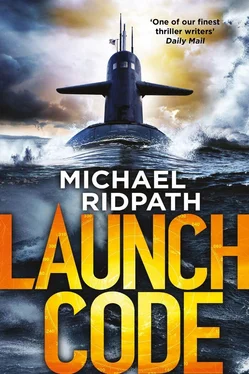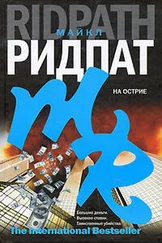Michael Ridpath
Launch Code
‘Never, perhaps, in the post-war decades was the situation in the world as explosive and hence more difficult and unfavourable as in the first half of the 1980s.’ Mikhail Gorbachev, leader of the Soviet Union, 1986
‘We may have been at the brink of nuclear war and not even known it.’ Robert Gates, Deputy Director of CIA and later Secretary of Defense
November 1983, Norwegian Sea
The end of the world looks like this.
Man creates the means to obliterate the planet: sixteen Poseidon missiles, each with their own ten independent warheads, enough to provoke a massive retaliation from the country at which they are fired. Machines transmit the order. Humans obey.
The doctrine of Mutually Assured Destruction, the doctrine which preserves peace in a nuclear world, demands that humans will obey, and that the enemy knows that they will obey.
Humans like Lieutenant William M. Guth (USN), assistant weapons officer on the USS Alexander Hamilton , loitering one hundred and twenty miles north-east of the Faroe Islands, deep in the cold embrace of the Norwegian Sea.
The Hamilton was Bill Guth’s first nuclear submarine. In the two years since he had joined the crew at the end of 1981, the Cold War had been steadily warming up. The rhetoric from the American president Reagan and the Soviet leader Andropov had become more heated, the Americans and the Russians were deploying intermediate-range nuclear missiles in Europe and in September a Korean airliner had been shot down having strayed into Soviet airspace over Eastern Siberia.
Yet Bill had become more confident in his own abilities and in the abilities of the crew members around him. They were never idle as they puttered along at three knots a few hundred feet beneath the surface. Ever more inventive training exercises simulated all manner of disasters from fires on board, to leaks, to shutting down the submarine’s nuclear reactor, to evading torpedo attacks.
And yes, to launching the Alexander Hamilton’ s nuclear weapons.
As assistant weapons officer, Bill had an important role in the complicated launch sequence, along with the twenty or so ‘missile techs’ who worked alongside him, and his immediate boss, the weapons officer.
He was making his way up the ladder to the upper level of the missile compartment when the announcement echoed through the submarine.
‘Alert One, Alert One!’
He scrambled to the top of the ladder, grabbed the bar over the hatch into the operations compartment and swung his six-foot frame feet first through the hole. He hurried the short distance to op-conn, the tiny room between the radio shack and the control room, where the printout of an Emergency Action Message waited for him. A few seconds later he was joined by his friend and fellow lieutenant, Lars da Silva.
Lars seemed tense, but calm. Beside them, the radio chief extracted code manuals from his safe and dropped them on the tiny desk with a thud.
‘Let’s do this,’ said Lars.
Bill didn’t feel calm; Bill felt scared.
This was their fifth patrol together. During that time Bill and Lars had decoded dozens of EAMs, real and simulated, many garbled in ingenious ways. Over the last two days a sequence of four EAMs had been received, each more concerning than the one preceding it. The most recent, received at 0512 that morning, had raised the level of readiness for nuclear war to DEFCON 2, which was only one step from launching missiles.
The whole crew had been waiting for the next message. Dreading it. And here it was.
Bill pushed the fear to one side and started decoding the string of four-letter groups.
This message wasn’t garbled. This message was very clear.
Lars glanced up at Bill. ‘Holy shit.’
Bill closed his eyes and nodded.
Bill had no time to think about the decoded message in his hand. He had trained for this. He knew what to do.
Followed by Lars, Bill carried the EAM through to the control room. The blood was thudding in his ears, and he was holding the scrap of paper so tightly it was shaking slightly, but he was careful to freeze the muscles in his face.
Maybe he looked as calm as the rest of the crew. Maybe they were as scared as he was.
He handed the message to the captain, who was waiting for him, a briefcase of top-secret launch manuals at his feet.
‘Captain,’ Bill began, uttering words he had used in training many times before. His voice sounded flat and surprisingly calm, at least to his own ears. ‘We have received a properly formatted message from the National Command Authority for strategic missile launch.’
‘I concur,’ said Lars next to him.
Commander Driscoll was a short man with wavy iron-grey hair and round glasses. He exuded quiet authority. His voice, tinged with a slight Texan twang, was always measured and calm. He commanded with his eyes. They were blue, and by turns could be reassuring, inspiring, angry or urgent. Now they were alert, expectant, ready for the message that he knew was coming.
He reached out for it, reading it with the tall figure of Lieutenant Commander Robinson, the boat’s executive officer, at his shoulder.
EMERGENCY ACTION MESSAGE
FROM: NATIONAL MILITARY COMMAND CENTER
TO: USS ALEXANDER HAMILTON (SSBN-617)
SUBJECT: NUCLEAR MISSILE LAUNCH — SINGLE INTEGRATED OPERATIONAL PLAN (SIOP) EXECUTION
REMARKS:
1. SET DEFCON ONE
2. RETARGET AND STRIKE
3. IMMEDIATE LAUNCH THREE (3) POSEIDON MISSILE SORTIES
4. TARGET PACKAGE SLBM 36155/4
5. AUTHENTICATION: ECHO TANGO TANGO ROMEO ZULU ALPHA HOTEL
‘I concur,’ said the XO.
‘Captain, request permission to authenticate,’ Bill asked.
‘Permission granted.’
Each stage of the process, from the initial receipt of the EAM to the eventual launch, was carefully scripted with procedures that were spelled out in checklists and orange folders marked ‘Top Secret’, procedures that had been refined over the years to ensure that there were always at least two officers involved at each stage or, in the case of the launch order itself, four.
The crew knew each stage intimately, but part of the procedure was that the checklists had to be followed to the letter. Nothing could be assumed. Nothing could be skipped.
The next stage of the process required an authentication code on the message to be compared to a code printed on a card locked deep inside two safes on the submarine. This was to ensure that the message had really come from National Military Command Center, and not some maniac with a desire to start a nuclear war.
The safes were back in op-conn. Lars opened the outer safe, and Bill opened the inner one. He pulled out the small package, ripped off the silver wrapping, and took the card back to the captain. Bill read out the authentication code on the card to Lars.
It matched the code on the EAM.
‘The message is authentic, sir,’ Bill said.
‘I concur,’ said Lars.
The XO glanced at the card and the message. ‘I concur.’
The captain reached for the 1-MC shipwide microphone. ‘Man Battle Stations Missile for Strategic Launch. Set Condition 1 SQ. Spin up missiles one, two and nine. The release of nuclear weapons has been authorized. This is not a drill. This is the captain speaking.’
Although he had heard the words many times before in training — with the exception of ‘this is not a drill’ — they came as a shock to Bill. Once again he could feel fear gnawing at the edges of his consciousness, once again he banished it.
Focus. Concentrate. Do your job.
Читать дальше












